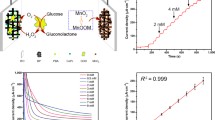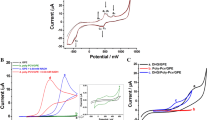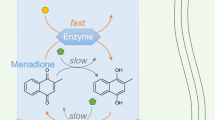Abstract
This paper describes the construction and characterization of a batch-type coulometric system for the detection of d-glucose using a novel FAD-dependent glucose dehydrogenase. In order to overcome the problem of interferents, such as ascorbate and urate, a potential-step method was proposed to separate the electrolysis reactions of interferents and d-glucose by selecting a mediator possessing an appropriate formal potential. The rapid oxidative consumption of the interferents proceeded in the first step, whereas the mediator and glucose remained reduced. In the second step, the mediator was immediately oxidized, and subsequent bioelectrocatalytic oxidation of d-glucose occurred with the aid of aldose 1-epimerase. In this study, potassium octacyanomolybdate (IV) with a formal potential of 0.6 V vs. Ag|AgCl was chosen as a mediator, and the first and second electrolysis potentials were set at 0.4 V and 0.8 V, respectively, by considering the heterogeneous electron-transfer kinetics and the potential window. The background-corrected response in charge corresponded to 99±2 % efficiency in terms of the amount of d-glucose.






Similar content being viewed by others

References
Cass AEG, Davis G, Francis GD, Hill HAO, Aston WJ, Higgins IJ, Plotkin EV, Scott LDL, Turner APF (1984) Anal Chem 56:667–671
Ikeda T, Katasho I, Kamei M, Senda M (1984) Agric Biol Chem 48:1969–1976
Kawaguchi M, Yoshioka T, Nankai S (1990) Denki Kagaku 12:1119–1124
D’Costa EJ, Higgins IJ, Turner APF (1986) Biosensors 2:71–87
Gregg BA, Heller A (1990) Anal Chem 62:258–263
Morris N, Cardosi MF, Bircb BJ, Turner APF (1992) Electroanalysis 4:1–9
Uchiyama S, Ono M, Suzuki S (1988) Anal Chem 60:1835–1836
Fukuya M, Ebisuya H, Furukawa K, Uchiyama S (1995) Anal Chim Acta 306:231–236
Heller A, Mao F, Heller E, Krishnan R, Vivolo JA, Colman FC, Feldman BJ, Funderburk JV (2000) WO Patent 0020626
Omura H, Sanada H, Yada T, Morita T, Kuyama M, Ikeda T, Kano K, Tsujimura S (2004) WO Patent 2004/058958 A1
Tsujimura S, Kojima S, Kano K, Ikeda T, Sato M, Sanada H, Omura H (2006) Biosci Biotech Biochem 70:654–659
Emr SA, Yacynych AM (1995) Electroanalysis 7:913–923
Mizutani F (1999) Bunseki Kagaku 48:809–821 (in Japanese)
Choi SH, Lee SD, Shin JH, Ha J, Nam H, Cha GS (2002) Anal Chim Acta 461:251–260
Taylor C, Kenausis G, Katakis I, Heller AJ (1995) Electroanal Chem 396:511–515
Whitby LG (1953) Biochem J 54:437–441
Leipoldt JG, L Bok DC, Cillers PJ (1974) Z Anorg Allg Chem 409:343–345
Bard AJ, Faulkner LR (2000) Electrochemical methods, fundamentals and applications, 2nd edn. Wiley, New York, Chap 11, pp 417–458
Claremont DJ, Pickup JC (1987) In: Turner APF, Wilson G, Karube I (eds) Biosensors: fundamentals and applications. Oxford University Press, Oxford, p 356
Acknowledgements
The authors would like to thank Ikeda Food Research Co., Ltd (Japan) for kindly donating FAD-GDH. This work was supported in part by grant-aid for scientific research from the Ministry of Education, Culture, Sports, Science, and Technology of Japan (MECSSTJ), and by COE for Microbial Process Development Pioneering Future Production Systems (COE program of MECSSTJ).
Author information
Authors and Affiliations
Corresponding author
Rights and permissions
About this article
Cite this article
Tsujimura, S., Kojima, S., Ikeda, T. et al. Potential-step coulometry of d-glucose using a novel FAD-dependent glucose dehydrogenase. Anal Bioanal Chem 386, 645–651 (2006). https://doi.org/10.1007/s00216-006-0421-6
Received:
Revised:
Accepted:
Published:
Issue Date:
DOI: https://doi.org/10.1007/s00216-006-0421-6



